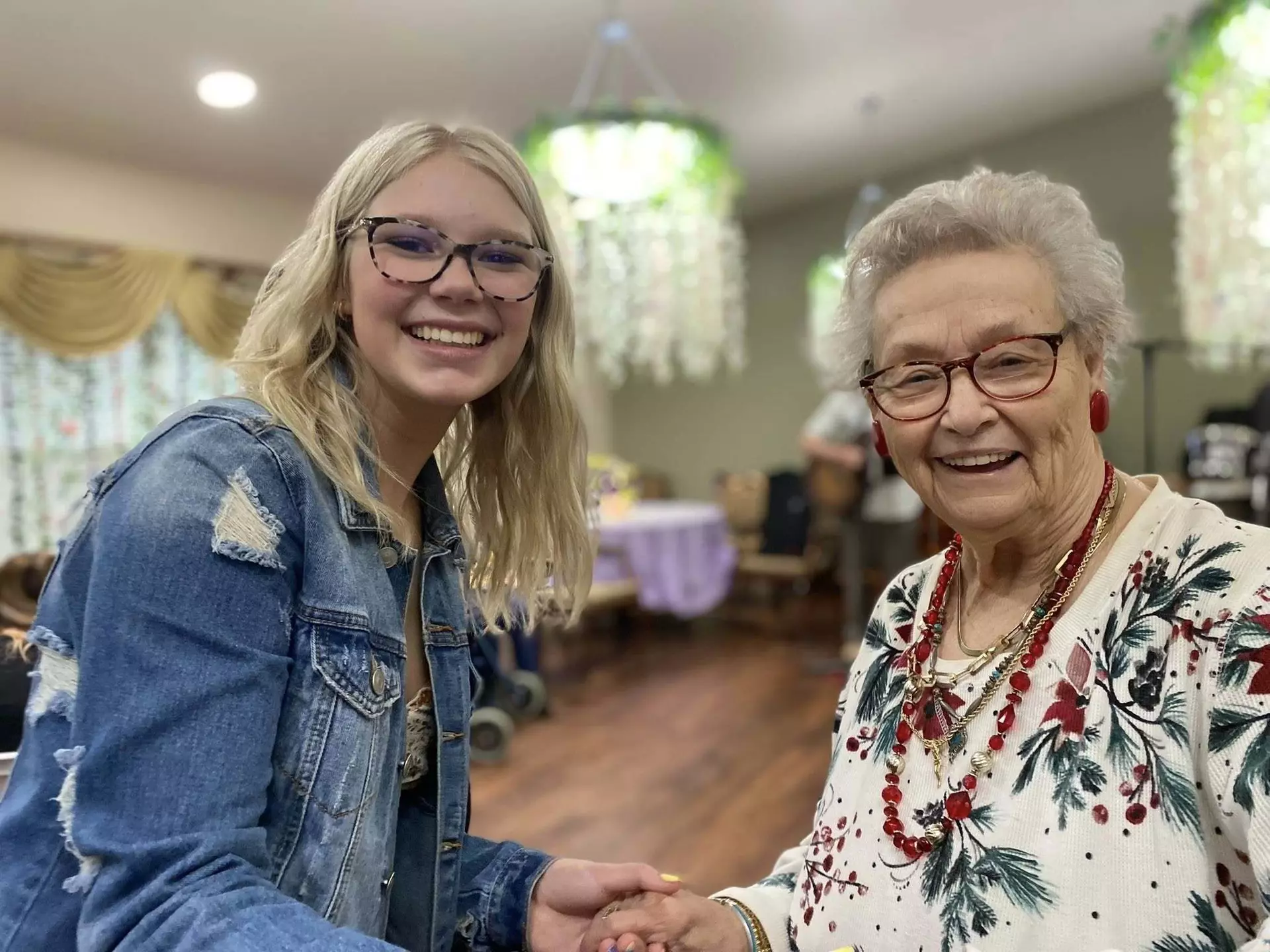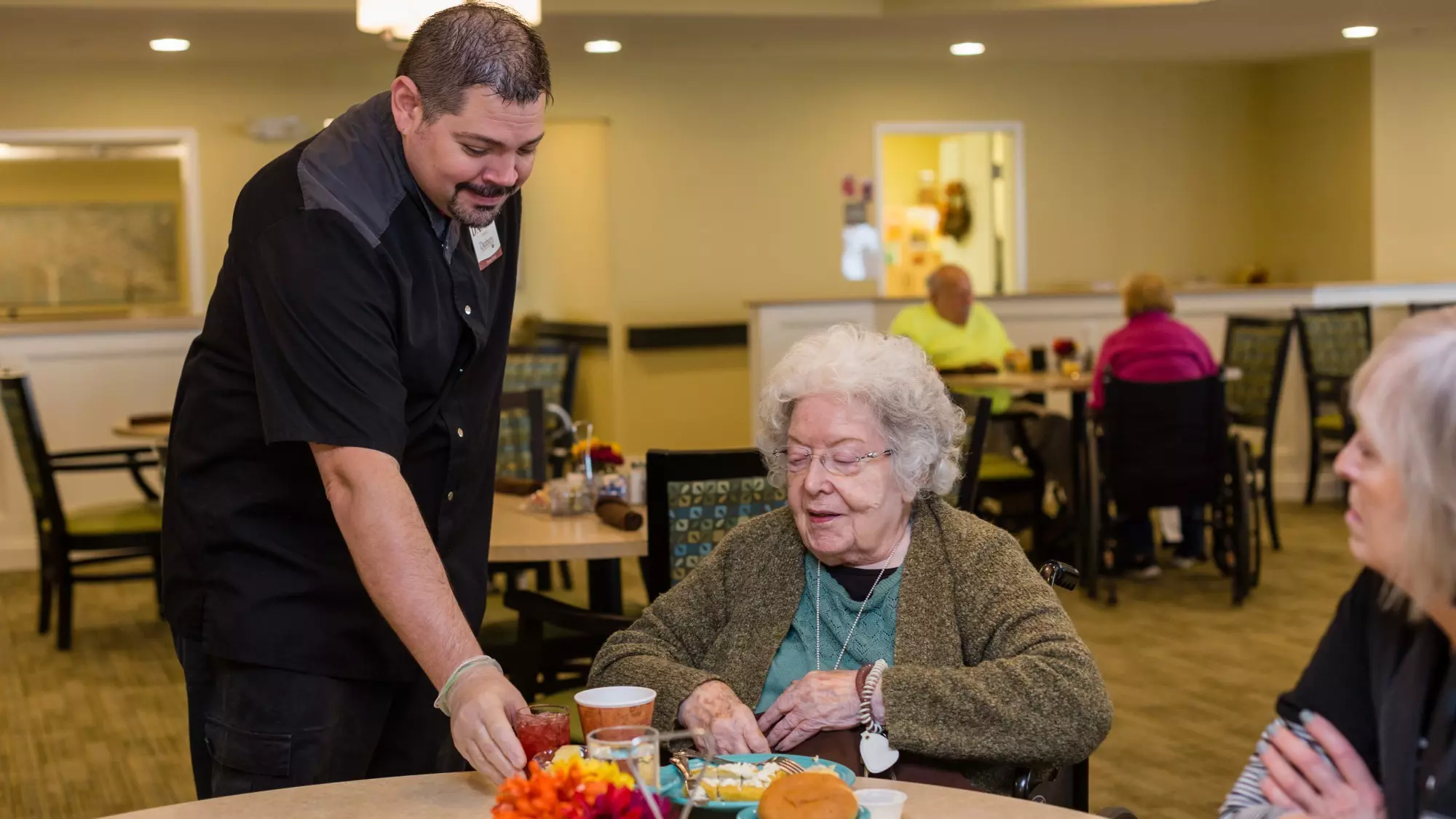While caregiving can be a rewarding and fulfilling experience, supporting an aging parent can also be challenging. As your family member’s needs progress, it’s normal to need extra help sometimes. At this point in your loved one’s journey, it may be helpful to educate yourself about available support services.
In this blog, we’ll talk about assisted living vs. hospice and how to choose the right option for your family member’s specific needs and circumstances.
What Is Assisted Living
Assisted living offers a mix of services and amenities to support residents’ needs and enhance their quality of life. This living arrangement allows your loved one to live as independently as possible while knowing help is always close if needed. Employees are typically available around the clock, seven days a week, to assist with activities of daily living (ADLs) like bathing, dressing, transferring, and using the bathroom.
Residents typically live in private or semi-private apartments with convenient access to modern amenities and shared spaces. You’ll also find plenty of planned activities and programs your loved one can join. Many communities partner with external providers to offer on-site medical care.

What Is Hospice Care
Hospice care is a type of support designed for individuals with a terminal illness, like advanced cancer, late-stage heart disease, or chronic obstructive pulmonary disease (COPD). The focus of hospice is providing comfort and dignity during a person’s final stages of life, as opposed to curative treatment.
Hospice care is typically provided by trained professionals, including doctors, nurses, social workers, chaplains, trained volunteers, and counselors, who work together to meet the physical, emotional, and spiritual needs of both the individual and their family. They may offer services like pain and symptom management, help with activities of daily living (ADLs), and counseling for family members.
Hospice can be offered in various settings, including a person’s home, assisted living communities, skilled nursing communities, or dedicated hospice centers, depending on the situation and what feels most comfortable. A person may qualify for hospice care if their condition is no longer responding to treatment or if their doctor has given them a prognosis of six months or less.
Key Differences at a Glance
When exploring additional support services for your loved one, it’s helpful to understand the key differences between assisted living and hospice.
To guide you, below is a chart comparing the two side by side:
| Category | Assisted Living | Hospice Care |
|---|---|---|
| Purpose | Supports daily living needs while promoting independence | Provides comfort and quality of life for those with a terminal illness |
| Who It’s For | Individuals who need help with activities of daily living (ADLs) such as bathing, toileting, or transferring | Individuals with a life expectancy of six months or less due to conditions like advanced cancer, heart disease, COPD, or dementia |
| Services Provided | Meals, housekeeping, personal care, medication management, social and recreational activities, and more | Pain and symptom management, emotional support, spiritual care, counseling, and guidance for families |
| Medical Care | Limited medical care, often through outside providers | Focused medical support from doctors, nurses, and hospice specialists |
| Living Arrangements | Residents live in private or semi-private apartments within a community | Support is provided wherever the person lives — home, assisted living, nursing home, or hospice center |
| Duration of Support | Ongoing, as long as the resident needs support | Typically limited to six months or less, though support may continue if needed |
Cost Comparison
Cost is often a key deciding factor when families compare assisted living vs. hospice. According to a recent survey, the national median monthly cost of assisted living in the U.S. is about $4,500. This fee usually covers accommodation, meals and snacks, assistance with activities of daily living (ADLs), and social activities. Keep in mind, however, that costs can vary significantly depending on the community and your loved one’s specific needs.
While Medicare generally doesn’t cover assisted living costs, it may help cover hospice services in some cases. If your family is considering hospice care in assisted living, those services are usually billed separately.

Can Assisted Living and Hospice Overlap
Yes, assisted living and hospice care can be provided simultaneously. In these cases, individuals usually remain in an assisted living community while a hospice team visits to provide necessary services. Hospice care in assisted living allows residents with terminal conditions to receive compassionate end-of-life support without having to move between communities.
When Is It Time for Assisted Living or Hospice
Deciding when to transition a loved one into assisted living or hospice care is never easy. You might be asking yourself, “When is it time for hospice?” or wondering about the differences between hospice vs. assisted living. These questions often come with a heavy heart. The truth is, there isn’t always a clear line.
There are some key signs to watch for, including:
| Signs to Look Out For | Support Provided |
|---|---|
| Struggles with activities of daily living (ADLs) like bathing, dressing, or eating | Employees are available to assist with personal care, housekeeping, and more. |
| Increased risk of falls or wandering | Added safety features and supervision to help keep residents safe |
| Loneliness or isolation at home | Plenty of planned activities and programs that encourage socialization with others |
| Trouble managing medications | Assistance with medication management |
| Home care is no longer enough | Professionally trained caregivers available around the clock |
| Signs to Look Out For | Support Provided |
|---|---|
| Serious illness has advanced, treatments are no longer working. | Improving comfort and quality of life |
| Frequent hospital visits or recent history of falls | Hospice team can provide support at home or in a community. |
| Uncontrolled pain or distressing symptoms | Pain relief and symptom management |
| Weight loss, fatigue, or reduced appetite | Nutrition guidance and assistance with feeding |
Alternatives to Consider
Not every situation requires a move to assisted living or hospice care right away. Depending on your loved one’s unique needs and circumstances, there are a few other services that may be worth looking into, including:
- Home Care: Families can hire professional caregivers privately or through an agency to provide extra help at home. Caregivers usually assist with activities of daily living (ADLs), like bathing, dressing, and eating. This option works well for seniors who want to remain at home while receiving necessary support. However, costs can add up quickly if round-the-clock support is required.
- Nursing Home: Nursing homes typically offer specialized support to help individuals recover following an illness, injury, or surgery. They’re also a great fit for individuals who require ongoing medical care, including those managing chronic conditions.
- Skilled Nursing: Skilled nursing provides a level of medical care similar to what you’d find in a hospital. They’re often equipped with medical professionals including doctors and licensed nurses who help support residents with various medical conditions. Skilled nursing is often ideal for individuals with complex medical needs, like chronic kidney failure, heart disease, or advanced diabetes.
- Memory Care: Memory care communities are designed specifically for people with memory challenges, including dementia and Alzheimer’s disease. They often feature secure layouts with enclosed outdoor spaces, large windows for natural light, and employees trained to meet the unique needs of residents living with memory conditions.
- Palliative Care: Both palliative care and hospice focus on managing pain and symptoms for individuals with serious health conditions. However, palliative care can be provided at any stage of illness, alongside curative or life-prolonging treatments like chemotherapy, dialysis, or surgery. Hospice care, on the other hand, can begin when a patient has a life expectancy of six months or less and chooses to stop curative treatments.
Which Option Is Right for You
Choosing the right support service for an aging parent is never easy, especially when life forces you to decide quickly. By taking the time to learn about available support services, including assisted living vs. nursing home vs. hospice, you can make a more confident and informed choice for yourself or your loved one.
Here’s a table comparing some key options you’ll typically come across:
| Care Option | Services | Best For |
|---|---|---|
| Home Care | Help at home with personal care, meal preparation, light housekeeping, transportation, companionship, and more | Individuals who wish to receive support surrounded by the love and warmth of close family members |
| Nursing Home | Qualified medical professionals, including doctors, nurses, and therapists, offer health care services | People recovering from illness, injury, or surgery |
| Skilled Nursing | Provides a level of medical care similar to what you’d find in a hospital | Those with complex medical needs or people who require daily medical attention |
| Assisted Living | Support with daily activities, combined with access to engaging life enrichment programs, restaurant-style dining, and thoughtfully designed amenities | Seniors who want to maintain an active, social lifestyle with just the right level of personalized support |
| Memory Care | A safe and supportive environment, with trained employees and thoughtfully designed amenities to support the unique needs of residents with memory changes | People with memory conditions, like dementia and Alzheimer's |
| Palliative Care | Treatment options alongside managing pain and symptoms for individuals with serious health conditions | People with serious illnesses who still want to continue treatments |
| Hospice care | Managing pain and symptoms for individuals, curative treatments are stopped | Families looking for compassionate end-of-life support |
StoryPoint Group Communities: Here for You and Your Loved One
At StoryPoint Group communities, we recognize the challenges families face in finding the best support for their loved ones. Please know you are not alone. We are here to help guide you and your parent every step of the way.
If someone you care about could benefit from additional support services, including assisted living, we’d love to be part of their journey.
To learn more about our communities or speak with one of our friendly community experts, contact us or schedule a tour at your nearby StoryPoint Group community.












